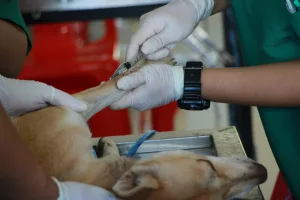Axolotls, with their charmingly unique appearance and captivating behavior, have become a favorite among aquatic pet enthusiasts. These creatures, often dubbed “walking fish,” are not only intriguing due to their regenerative abilities but also because of their distinct behaviors, such as tail curling. If you’re an axolotl owner or considering becoming one, understanding the nuances behind a curled tail can be crucial for the well-being of your pet. At first glance, a curled tail might seem ordinary, but it can signify a range of conditions, from everyday behavior to potential health concerns. Let’s dive deeper into what a curled tail means for your axolotl and how you can ensure their happiness and health.
Understanding Normal Behavior
Efficient Swimming and Maneuverability
In most cases, a curled tail is simply a functional behavior. Axolotls are natural swimmers, and their tails play a vital role in their aquatic agility. When an axolotl curls its tail, it’s often to aid in efficient propulsion through the water. This movement is akin to a rudder, helping them steer and stop with precision.
Example: Imagine watching your axolotl dart across the tank. As it picks up speed, the tail might curl to help navigate turns or slow down, much like how a cyclist leans into a turn to maintain balance. This is especially noticeable when they are in a playful mood or when evading something unfamiliar in their environment.
Playful Interactions
Axolotls are curious creatures, and their environment stimulates them to explore and interact. Tail curling can occur during playful activities, such as chasing a fellow tank mate or investigating new additions to their habitat. This behavior can be particularly observed when you introduce novel objects or creatures to their tank, creating a more enriching environment.
Stress and Anxiety Indicators
Recognizing Stress Signals
While some tail curling is normal, it can also signal stress or anxiety. Axolotls are sensitive to their environment, and factors like water quality, noise, or tank conditions can impact their stress levels. Stress in axolotls can manifest in various ways, and tail curling is often one of the first signs.
Practical Tips:
- Water Quality: Regularly test the water for ammonia, nitrites, and nitrates. Axolotls thrive in water free from these toxins. Consider a reliable water testing kit, which will quickly become your best friend in maintaining a healthy tank. Water changes should be performed regularly to ensure optimal conditions.
- Noise Levels: Position your tank away from high-traffic areas in your home. Excessive noise or vibrations can unsettle these sensitive creatures. Think of it as creating a peaceful sanctuary for your pet.
- Hiding Spots: Provide ample hiding places within the tank. Items like caves, plants, and logs offer your axolotl a sense of security and help reduce stress. These spots are not just for hiding but also for resting, which is essential for their well-being.
Environmental Adaptations
Axolotls are adaptable, but sudden changes can be jarring. Tail curling might occur if there’s a significant shift in their environment, such as a new tank mate or altered lighting conditions. Gradual changes are always preferable to avoid unnecessary stress.
Case Study: Consider an axolotl named Luna, who experienced tail curling after a new, bright aquarium light was installed. The increased light exposure led to stress, evident by her frequent tail curling. By adjusting the light intensity and adding more shaded areas, Luna’s stress levels decreased, and her tail curling subsided. This highlights the importance of observing your axolotl’s reactions to environmental changes.
Health Concerns and Symptoms
Potential Health Issues
If your axolotl’s tail curling seems persistent or is coupled with other symptoms, it might indicate a health problem. A vigilant approach to monitoring their behavior and health is essential.
Common Health Indicators:
- Bacterial Infections: Look for signs like redness or swelling. If your axolotl seems lethargic or isn’t eating, it’s time for a vet visit. Bacterial infections can progress quickly, so early detection is key.
- Injuries: Check for physical injuries that might cause discomfort or unusual behavior. These can result from tank mishaps or aggressive tank mates.
- Genetic Abnormalities: Some axolotls may be predisposed to certain conditions that can affect their behavior. Regular health check-ups can help you stay informed about potential genetic issues.
Veterinary Assessments
Regular check-ups with a veterinarian experienced in exotic pets can help identify and treat potential health issues early. They can also guide you on the best practices for maintaining your axolotl’s health. Establishing a relationship with a knowledgeable vet can be invaluable for unexpected health concerns.
Environmental Factors and Their Impact
Maintaining Optimal Water Conditions
The environment is a crucial factor in preventing stress and health issues. Ensuring that your tank is a stable and suitable habitat is fundamental. Remember, axolotls are as much a product of their environment as they are of their genetics.
Key Water Parameters:
- Temperature: Axolotls prefer cooler water, ideally between 60-64°F (16-18°C). Avoid drastic temperature shifts. Using a reliable aquarium thermometer can help you keep track of any changes.
- pH Levels: Maintain a neutral pH around 7.4-7.6. Regular monitoring can prevent stress-related behaviors. A simple pH test kit can be a lifesaver in maintaining balance.
- Filtration Systems: Use a gentle filtration system to keep the water clean without causing strong currents that might stress your axolotl. A sponge filter is often recommended for axolotl tanks due to its gentle filtration and oxygenation.
The Role of Tank Setup
A thoughtfully arranged tank can significantly enhance your axolotl’s quality of life. Consider the following elements:
- Substrate Choice: Use sand or a bare bottom to prevent impaction, which can occur with gravel. Gravel should be avoided as it poses a risk of ingestion.
- Decorations and Enrichment: Incorporate a variety of plants and structures for exploration and enrichment, promoting natural behaviors. Live plants not only enrich the environment but also help maintain water quality.
Observing and Understanding Behavior
Monitoring Your Axolotl
Regular observation is key to understanding your axolotl’s needs and behaviors. Note any changes and consider keeping a journal to track patterns or recurring issues. This can become a valuable tool in identifying potential health or environmental problems.
Common Mistakes to Avoid:
- Ignoring Subtle Signs: Tail curling, when persistent, should never be overlooked. Pay attention to other behaviors or physical changes. Early intervention can prevent more serious health issues.
- Overcrowding the Tank: Ensure your axolotl has enough space. Overcrowding can lead to stress and competition for resources. A spacious tank encourages healthy interactions and exploration.
Building a Bond with Your Axolotl
Interaction and Bonding
Building a bond with your axolotl means more than just feeding them. Spend time observing them and gently interacting with them through the glass or during feeding times. This can enhance your understanding of their personality and preferences.
Feeding Tips:
- Variety in Diet: Offer a balanced diet with live or frozen foods like bloodworms or brine shrimp. This not only caters to their nutritional needs but also encourages natural foraging behavior. Avoid overfeeding, as it can lead to obesity and water quality issues.
- Scheduled Feeding: Establish a consistent feeding schedule, which helps reduce stress and promotes healthy digestion. A routine is comforting for axolotls and helps in maintaining a stable environment.
Enrichment and Stimulation
Creating an Interactive Environment
Enrichment is crucial for an axolotl’s mental and physical health. A stimulating environment promotes natural behaviors and reduces stress.
Ideas for Enrichment:
- Varied Scenery: Regularly change the layout of the tank decorations. This stimulates curiosity and exploration.
- Interactive Feeding: Use feeding tweezers to engage your axolotl during mealtime. This mimics hunting and enhances mental stimulation.
- Tank Mates: If considering tank mates, choose species that are compatible with axolotls. Generally, axolotls do well alone, but if you add fish, ensure they are non-aggressive and won’t nip at the axolotl’s gills.
Recognizing Behavioral Patterns
Long-term Observation
Long-term observation can provide insights into your axolotl’s behavioral patterns. Understanding these patterns can help in identifying deviations that may indicate stress or illness.
Recording Observations:
- Behavior Log: Keep a log of daily activities and any unusual behaviors. This can be a simple notebook or a digital document.
- Photo Records: Take periodic photos of your axolotl to track physical changes over time. This can aid in identifying subtle health issues.
Troubleshooting Common Issues
Problem-solving Strategies
When issues arise, a methodical approach can help in diagnosing and resolving problems.
Steps to Troubleshoot:
- Identify the Symptom: Start by identifying the primary symptom, such as persistent tail curling or refusal to eat.
- Check Environmental Factors: Review water quality, temperature, and tank setup. Make necessary adjustments.
- Consult Resources: Use online forums, books, and expert advice to gather information on potential causes.
- Professional Help: If the issue persists, consult a veterinarian for a professional assessment.
Creating a Lifelong Plan
Long-term Care Strategies
Caring for an axolotl is a long-term commitment. Developing a care plan can help ensure their health and happiness over the years.
Components of a Care Plan:
- Routine Maintenance: Schedule regular tank cleanings, water changes, and health checks.
- Emergency Preparedness: Have a plan for emergency situations, such as sudden illness or equipment failure.
- Continued Learning: Stay informed about axolotl care through research and community engagement.
Caring for an axolotl is a rewarding experience that requires attention to detail and a deep understanding of their unique needs. By recognizing the significance behind a curled tail, you can better cater to your axolotl’s well-being. Through proper care, observation, and environmental management, you can ensure that your axolotl remains healthy, happy, and a delightful companion for years to come.



